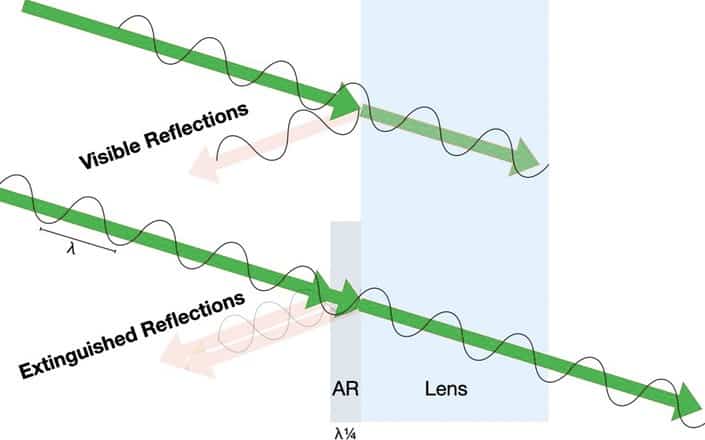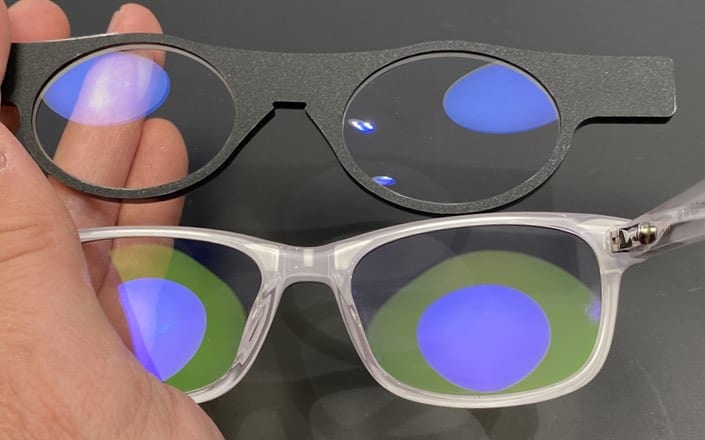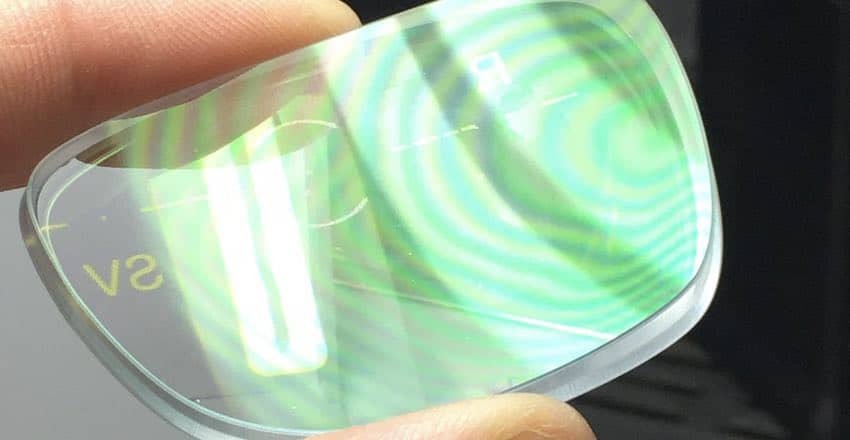The green or blue reflection on your glasses is the color of the remaining 1% reflection on the lenses of your glasses the anti-reflective coating could not eliminate. This colored reflection is also known as the bloom. Depending on the manufacturer the color will be more tuned to a dark green or a dark blue.
The better the quality of the anti-reflective coating is the fewer reflections you can notice wearing the lenses. Usually, those reflections are easily visible to you when you hold your glasses in your hands and turn them around a little so a light source can like a lamp gets mirrored on the lens surface.
Usually, those effects are blue and green mirror effects on the lens surface of your glasses are rarely noticeable for you. Depending on the angle someone standing in front of you your eyes could be covered by the blue or green reflections depending on the light sources around you.
When anti-reflective coatings are engineered it is currently not possible to block out all the light. A tiny rest still gets reflected. The engineer of the anti-reflective coating needs to decide whether to choose blue, green, or even another color of the remaining reflections on the lenses.
In the end, it is worth noting that people wearing oversized glasses will notice reflections more than people with smaller glasses. The more lens surface you have in front of your eyes the more reflections are theoretically possible.
When you wear big glasses and the lighting around you is very unfavorable you might even see objects around you in the blue or green color of the reflection on your glasses.
This can be very disturbing and can be minimized with a really good anti-reflective coating as well even not more with smaller glasses.
What Causes the Blue and Green Reflections on the Glasses Actually?
Anti-reflective coatings consist out of different layers on top of each other. Every layer reflects some portion of the light spectrum as seen below which causes interferences and therefore a reduction of glare on the lens surface.
Due to the multiple wavelengths in the visible light spectrum, the coating needs to be fine-tuned to reduce most of the glare. The engineer needs to produce layers that have different thicknesses designed to produce interference in combination with a certain wavelength.

As you can imagine the multiple layers on the lens surface can not be matched perfectly to every visible wavelength. When some reflection is remaining on the lens surface of your glasses the manufacturer usually decides for a dark green or blue because those reflections are less noticeable to the wearer and to someone looking at your eyes.
When this antireflective coating works best the blue or green reflections on the lenses are reduced to a minimum is currently at approximately 1% reflection on the lens surface. Most manufacturers have their coatings on a great level but there are also differences in the quality of the coatings.
Just have a closer look at the image below. Here you can see a good example of an anti-reflective coating on top with minimal blue reflections and a coating below in the glasses which produces even a combination of blue and green glare. This is actually not common.

But usually, you will find more reflections on your glasses with cheaper lenses. Personally, I like the coatings with the dark green reflections best. They are just even a little less visible compared to the blue ones. In seldom cases, you will find yellow, gold, or red glare on your anti-reflective coating. As I said. depending on what is fine-tuned the color on your lens surface will change.
The design of an efficient antireflection coating is very complex and delicate. Increasing the number of layers in a stack to theoretically improve its spectral performances may result in poorer performance than expected from simpler designs because thickness variations can change this entire system’s output significantly.
In the picture below you can see me wearing two different pairs of glasses with different reflections on them. The one with the brighter green on the left side worked not so well driving at night and produced nagging reflections on the back surface. Both pictures were done in the same lighting condition with the same frame to see the differences best.

Why Do I See Rainbow Circles on My Glasses?
Despite the classic blue and green reflections on the lens surface some people are faced with rainbow circles on their glasses. This is also caused by the anti-reflective coating but when circle-like structures are visible on the lens surface the layer thickness is off-target. I saw this mostly in my workshop with lenses that got spin-coated.
Usually, such a bad quality should not leave the manufacturers’ quality control. The probability for rainbow circle structures on your lenses is also higher depending on the lens material you buy. Usually, a rule of thumb says the thinner the lenses the more dominant the colors on the lens surface will appear. This is true for blue and green as well as for the rainbow circles.
In some cases, those reflections can get as extreme as shown in the picture below. Depending on the light source you shine on those lenses the effects will be more or less visible.

To avoid those circle patterns I would switch to another manufacturer and or choose another base material. Usually, your local optician knows which manufacturer produces which best and you can trust him with the optimization.
If you want to learn more about anti reflective coatings I have a buyers guide for them ready here for you.
Conclusion
Now you know what causes the blue and green reflections on the lens surfaces. And as you saw in the examples above when the anti-reflective coating does not work well it produces even circle-like rainbow colors. I hope you have found the information you were looking for about glasses.
I wish you a great day.
